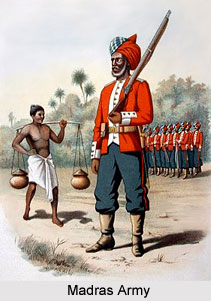 The History of Madras Army can be traced back to the year 1757, when the British East India Company became determined to form military units. The Army of Madras Presidency was established with the purpose of protecting the commercial interests of the British East India Company. Initially the troops were not well trained, but after the attack of the French and the seizure of Madras (now Chennai) in the year 1746, the British administration decided to develop trained armed forces. The military units conducted various operations, captured territory and coerced allegiance from the native rulers. The armed forces were roughly formed separate military units which were later merged to form battalions and Indian officers commanded the native troops.
The History of Madras Army can be traced back to the year 1757, when the British East India Company became determined to form military units. The Army of Madras Presidency was established with the purpose of protecting the commercial interests of the British East India Company. Initially the troops were not well trained, but after the attack of the French and the seizure of Madras (now Chennai) in the year 1746, the British administration decided to develop trained armed forces. The military units conducted various operations, captured territory and coerced allegiance from the native rulers. The armed forces were roughly formed separate military units which were later merged to form battalions and Indian officers commanded the native troops.
In 1760, the troops of Madras Army participated in the battle of Wandiwash, which was amongst their first major military actions. The military personnel of the battalion were highly appraised for their significant service. Eventually a part of the unit was transferred to the province of Bengal under the command of Robert Clive. During the initial years of its formation, the officers of the Madras Army were rather conscious of the social hierarchy, attire, caste rituals and customs of the native soldiers. Even landowners in the province became members of the armed forces. Muthu (Mootoo) Nayak from Madura was one of the noted landowners who joined the Madras Army.
Subsequently the Madras Army developed and the British East India Company recruited new officers, which worsened the leadership and attention of the men. This led to the incident of the Vellore mutiny in the Army of Madras Presidency. The officers of the East India Company organized looting activities frequently. Lord Wellesley, the Duke of Wellington, shared the loot with each officer and Sepoy. After the death of Tipu Sultan and the defeat of Hyder Ali, the lootings increased rapidly through out the territory, particularly in Seringapatnam. Moreover the 2 sons of Tipu Sultan were imprisoned by the British administration in Vellore Fort. Such activities of the Madras Army officers infuriated the native Indians through out the country.
During the 1830s, the Madras Army evolved into a professional armed military force. The Government of the province of Madras primarily used the battalion for internal security campaigns and other administrative operations. The army was developed for the defence of the state against internal and external enemies. The British officers knew of the integral strengths and weaknesses of a multi-ethnic armed force that could not invoke patriotism. The Army of Madras Province tried to subdue the weaknesses through various programs such as offering paternalistic care for the sepoys and their families and by recommending the study of Asian languages by the English officers. The unit was mainly put together to provide support to the civil administration for securing the revenue and sustaining serenity.
The Madras Army remained nearly unchanged even after the Great Revolt of 1857, also known as the Sepoy Mutiny in 1857. All of the 52 regiments of Madras Native Infantry maintained loyalty to the British East India Company. The regiments were later reassigned to the new British Indian Army after the East India Company was replaced by the British Empire in India.



















